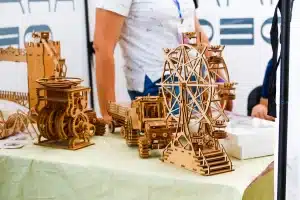The Fascinating World of Toy Designers and Innovators
Toys have always been an integral part of childhood. They spark imagination, encourage creativity, and provide hours of entertainment for children all over the world. Have you ever wondered about the minds behind these incredible toys? Toy designers and innovators are the unsung heroes who bring joy to children’s lives through their innovative creations. In this article, we will delve into the fascinating world of toy designers and the features that make their work truly remarkable.
What Do Toy Designers Do?
- Conceptualize and visualize toy ideas:
- Prototype development:
- Collaboration with manufacturers:
- Continuous improvement:
Toy designers imagine and conceptualize new toy ideas that cater to the interests and developmental needs of children. They use their creative skills to sketch and visualize these ideas, transforming them into tangible concepts.
Once the initial concept is formed, toy designers create prototypes to test the functionality and appeal of the toy. They carefully refine the design, ensuring it meets safety standards and provides an engaging experience for children.
Toy designers collaborate closely with manufacturers to bring their concepts to life. They work together to determine the production techniques, materials, and manufacturing processes required to produce the toys on a large scale.
Toy designers constantly seek feedback and make improvements to their designs. They conduct market research to understand children’s preferences and trends, allowing them to adapt their creations to the ever-changing toy landscape.
Features of Remarkable Toy Design
Toys that capture the hearts and minds of children often possess certain features that set them apart from the rest. Here are some key attributes of remarkable toy designs:
- Innovative and unique:
- Engaging play value:
- Age-appropriate:
- Durable and safe:
- Emphasis on sustainability:
- Appealing aesthetics:
Remarkable toy designs feature innovative and unique concepts that spark children’s curiosity. These toys offer novel experiences, encouraging imaginative play and cognitive development.
Great toys captivate children by providing engaging play value. They offer interactive elements, encourage problem-solving, and stimulate sensory experiences to keep children entertained for hours on end.
Toy designers understand the importance of creating toys that suit different age groups. They consider developmental milestones and design toys that challenge and stimulate children accordingly, helping them learn and grow through play.
Remarkable toy designs prioritize durability and safety. They are built to withstand rough play and are made from materials that are free from harmful chemicals. Safety testing is a crucial aspect of the toy design and manufacturing process.
In today’s environmentally conscious world, remarkable toy designs place emphasis on sustainability. They aim to reduce waste and carbon footprint through the use of eco-friendly materials and packaging.
Visual appeal plays a significant role in toy design. Remarkable toys have eye-catching aesthetics that attract children and spark their interest. Vibrant colors, engaging textures, and appealing characters contribute to the overall allure of these toys.
The Future of Toy Design
The world of toy design is constantly evolving, fueled by advancements in technology and changing societal needs. As we look ahead, there are several trends that might shape the future of toy design:
- Integration of technology:
- Focus on educational toys:
- Customization and personalization:
- Inclusion and diversity:
Toy designers are incorporating technology like augmented reality (AR) and virtual reality (VR) to create immersive and interactive play experiences. These technologies offer new dimensions of engagement and learning for children.
With an increasing emphasis on learning through play, toy designers are focusing on creating educational toys that combine entertainment and cognitive development. These toys facilitate learning in areas such as STEM, language skills, and problem-solving.
Personalization is gaining popularity in various industries, and toy design is no exception. Toy designers are exploring avenues for customization, allowing children to create toys that reflect their individuality and interests.
Toy designers are recognizing the importance of diversity and inclusivity in toy design. They are creating toys that represent different cultures, ethnicities, and abilities, fostering empathy and understanding among children.
In Conclusion
Toy designers and innovators are the creative geniuses behind the toys that bring joy to children’s lives. Their ability to conceptualize, design, and refine toy ideas is truly remarkable. Remarkable toy designs possess features that engage, inspire, and educate children while ensuring their safety and durability. As technology advances and societal needs evolve, toy design will continue to adapt and transform, paving the way for even more fascinating creations in the future.





